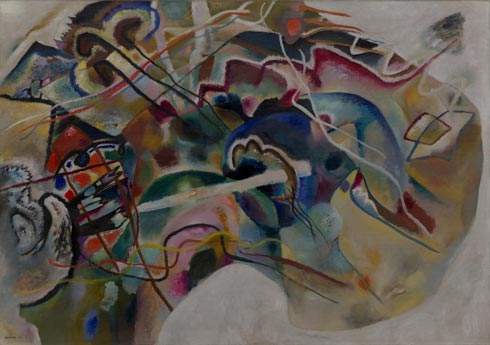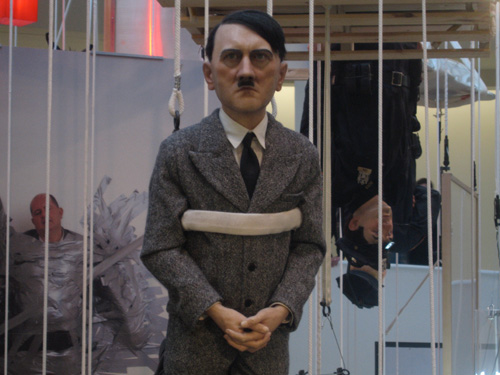At just the moment, midway down the ramp of the Guggenheim, when the Maurizio Cattelan retrospective installation, All, began to lose its amusing edge and spectacular novelty, and become tiresome, I was led off-ramp, off-track by my friend Susan Bee who had escaped through a small portal to see Kandinsky’s Painting with White Border, a small show of paintings and drawings devoted to one painting by Kandinsky, among the Museum’s earliest acquisitions. I don’t much like Kandinsky, the forms in his paintings irritate me–hackles down, Kandinsky fans (and Susan is one of them): it’s possible to completely understand an artist’s extraordinary importance to the development of modernism and still find the work, its shapes and lines, atavistically annoying. Painting with White Border is no exception, and yet I found the exhibition very interesting and useful.
If Cattelan’s combination of spectacular presentation, whimsical detail, and bad boy provocations, all twisted from the real, might seem like Alice’s Wonderland, somehow having gone around a curved corner of the Guggenheim into the Kandinsky exhibition, I felt like I’d fallen down the rabbit hole into another Wonderland–the one where an artist works his way by hand through known problems to unknown solutions to arrive at a work.
I know one could say the same of Cattelan–he had to figure out where each provocation should be aimed and how to present diverse site specific works in the unforgiving space of the Guggenheim, and he did it. Also, even an abstract painting is not entirely an unknown entity, it arrives into being from formal and philosophical problems and inspirations, yet the two exhibitions offer different examples for a young artist. One is surely very seductive yet nearly impossible to follow because it’s not enough to be a very clever boy, over and over again, you also have to persuade people to give you a lot of money, if anything a greater and more mysterious talent. So perhaps the other more old-fashioned model can be followed, not to the same formal conclusion, but because it offers a trace of process presumably accessible to any artist.

Vassily Kandinsky, Painting with White Border (Bild mit weissem Rand, May 1913),Oil on canvas, 140.3 x 200.3 cm. Solomon R. Guggenheim Museum, New York, Solomon R. Guggenheim Founding Collection
What grabbed me, more than the painting, was a film about it shown within the exhibition: Kandinsky: A Close Look (3 Paintings: 3 Investigations), by Grahame Weinbren. Grabbed is a crude word, but in fact I was lured into the little room in which it was playing in exactly the same way that you are lured into buying food at Zabar’s: I was intrigued by the sound track leaking into the exhibition alcove which featured the painting that was the focus of the exhibition–a strongly accented voice, sounding something like if Slavoj Žižek were reading the Zabar’s echt-New York Upper West Side sales patter out loud, “Shoppers: fresh out of the oven right now at our bakery, Zabar’s own rye bread, we have Nova… .” The film is a visual examination of the painting, guided by Kandinsky’s essay about it, read out loud by an actor with a Russian accent, as described. Once you get past the slight hokiness of the accent, you are absorbed into Kandinsky’s journey through conceiving of and struggling to find the solution to this large canvas, over a period of several months, in 1913, as expressed in an essay he wrote about it. It is an excellent example of descriptive writing, articulate and expressive, eloquent as to goal, process, result, as Kandinsky describes his concerns and his own critical views of what he is doing in each part of the composition–of three brown forms dominating the upper left of the work, Kandinsky writes that “this combination of form takes on a wooden quality that I find distasteful.” He continues, about the use of green,
“For instance the color green often (or sometimes) awakens in the soul (unconsciously) overtones of summer. And this dimly perceived vibration, combined with a cool purity and clarity, can in this case be exactly right. but how distasteful it wold be if these overtones were so clear and pronounced that they made one think of the “joys” of summer: e.g., how nice it is in summer to be able to leave off one’s coat without danger of catching cold.”
He picks up on the use of green a bit later: “It was quite unconsciously–and, as I see now, purposefully–that I used so much green: I had no desire to introduce into this admittedly stormy picture too great an unrest. Rather, I wanted, as I noticed later, to use turmoil to express repose. I even used too much green, and especially too much Paris blue ) a dully sonorous, cold color), with the result that it was only with exertion and difficulty that I was later able to balance and correct the excess of these two colors.”
He concludes his description of the painting with the genesis of the white border itself:
At the bottom left, there is a battle in black and white, which is divorced from the dramatic clarity of the upper left-hand corner by Naples yellow. The way in which black smudges rotate within the white I call “inner boiling within a diffuse form.”[…]
I made slow progress with the white edge. My sketches did little to help, that is, the individual forms became clear within me–and yet, I could still not bring myself to paint the picture. It tormented me. After several weeks, I would bring out the sketches again, and till I felt unprepared. It is only over the years that I have learned to exercise patience in such moments and not smash the picture over my knee.
Thus, it was not until after nearly five months that I was sitting looking in the twilight at the second large-scale study, when it suddenly dawned on me what was missing–the white edge.
I scarcely dared believe it; nonetheless, I went straightaway to my supplier and ordered the canvas.[…]
I treated this white edge itself in the same capricious way it had treated me: in the lower left chasm, out of wish rises a white wave that suddenly subsides, only to flow around the right-and side of the picture in lazy coil, forming in the upper right a lake…disappearing towards the upper left hand corner, where it makes it last, definitive appearance in the picture in the form of a white zigzag.
Since this white edge proved the solution to the picture, I named the whole picture after it.
The artist’s exegesis of the painting, in its becoming, is technologically enhanced by the film which travels to each area as he writes about it though, curiously, if you place yourself just so at the edge of one of the benches in the little room where the film is projected, the painting and the film can be looked at more or less in one view, and the painting to my mind suffers in the juxtaposition: it is less bright than the film and one must take it in its totality as a complex composition, while in the film each area springs to life as Kandinsky writes about it. What is exciting is how eloquent Kandinsky is as he interweaves his goals, his process, his materials, forms, and opinions. To him the painting was a world, and a space of discovery, with the “white border” (a wavy white shape that frames the right half of the work) the linchpin.
I found this cinematic reading compelling because I’m interested, as an editor and a teacher, currently working with MFA students who must in some way incorporate description of their work into their writing, in how one can use detailed description of the visual appearance of a work to get at other aspects of the work that are contained within the visual elements: narrative content, and aesthetic, philosophical, or political intent.
Now refueled, Susan and I reentered the carousel and made our way down past the hanging horse and the stricken pope and other amusements, and out into the city.

Maurizio Cateelan, "Him", 2001, Polyester resin, wax, pigment, human hair, and suit, seen January 9, 2012

Wig store window, West 27th Street, NYC, seen January 9, 2012
Kandinsky’s essay on Painting with White Border is included in his Reminiscences, published by Der Sturm Verlag in 1913, with his descriptions of three paintings, including Painting With White Border. It is not available in totality online, which perhaps is a good thing, because it is the synaesthetic experience of seeing and hearing that is so interesting and dynamic and that I highly recommend: the show closes the 15th of January.
